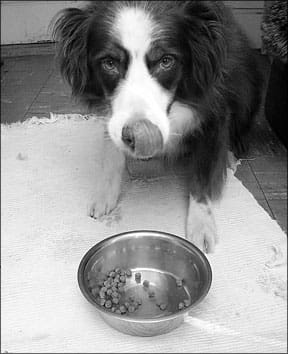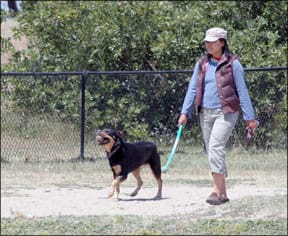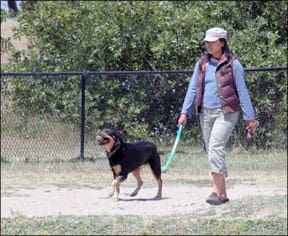Consider the plight of canine Brandy, a seven-year-old mixed breed, adopted by a suburban family with three kids. In the five years they have shared their home with Brandy, his status in the family has gone from that of a rock star to a pet rock to a neglected pet. Today, he’s got some problems – health-related issues and dog behavioral trouble – and the head of the family is seriously considering “getting rid” of him.
Although this concept induces wails of protest from the kids, honestly, who would will miss the silent onslaught of Brandy’s deadly farts, or cleaning up the sloppy, gloppy piles of poop he leaves in the backyard three or four times a day? Who wouldn’t appreciate being able to leave shoes and socks and cell phones on the floor, without a dog who would chew and swallow them the moment your back was turned? And wouldn’t it be nice to be able to bring friends over to the house without having to lock Brandy in the garage, to keep him from barking and nipping at the visitors? He pulls hard on leash and is sometimes aggressive to other dogs, so he rarely gets taken for the walks that might calm him down.

288
But wait; Mom loves the dog, farts and all, and doesn’t think it’s fair to send him back to the shelter just because no one is enjoying him much anymore. She thinks Brandy needs some time and attention, and can be made to resemble the better-behaved, better-loved young dog they adopted years ago. She’s ready to call the vet for an appointment for a consultation – or should she hire a professional dog trainer?
Multi-pronged approach
The answer is yes! She should probably make an appointment with both experts, and here is why:
Training approaches that fail to address Brandy’s health problems – his poor digestion, hyperactivity, and pica eating (consumption of nonfood items) – may improve some of his behavior for a short time. But his poor health will make it difficult for him to absorb and retain the lessons.
Improvements in Brandy’s health will make him more pleasant to live with; with an improved diet and some targeted supplements, he will surely stop producing so much gas, and his feces will become smaller, harder, and less frequent. His pica eating should also decrease. If he feels better, he may become less aggressive to other dogs while being walked. However, remedial training will probably be necessary to improve his behavior enough to enable the kids to walk him again, or to have their friends safely interact with him.
Every aspect of a dog’s life affects every other aspect, which can make it difficult to decide where you should start with a dog like Brandy. No single effort you make, no matter how huge, will miraculously turn everything around. A homemade diet might vastly improve his health, but he may still be a pain to live with. Twice-weekly private lessons with a positive trainer might solve almost all of the complaints about Brandy’s behavior, but won’t make him (or the backyard) smell any better!
The good news, though, is that a multi-pronged, holistic approach, comprised of incremental, intelligent improvements in his life, just may save the dog.
Where do you start?
Most holistic veterinarians say the most important part of a health-promotion plan is improved diet; most trainers will say it’s increased exercise. We propose that these two keystones of health are equally important; both need to be implemented ASAP.
Unless your dog is in peak health, and eating a home-prepared diet of fresh foods, you can improve his diet. If you already feed a high-quality product, but your dog still has persistent digestive problems or any signs of food allergy, you should try a change of food.

288
Look for a different variety of food from the same maker, or a product from a different line, or, best yet, an entirely different product from a different maker. If you feed kibble, consider a dehydrated food, like the products from The Honest Kitchen, or a frozen raw diet. Make notes on your calendar or in a notebook indicating when you switch foods, and what type and variety of food you use.
If you are feeding a low-quality food, you should buy a higher-quality product. Foods that contain greater amounts of high-quality proteins and fats provide more of the nutrients beneficial to dogs, including a more complete panel of amino acids and omega-3 and omega-6 fatty acids.
An improved diet can make a world of difference to the attitude and responsiveness of a dog who suffers from a chronically upset stomach.
Very few dogs receive adequate opportunities to exercise as much as their wild ancestors did – or even as much as their more recent ancestors did just a few decades ago. Exercise releases endorphins, making the dog feel better. It strengthens bones and soft tissues, and burns calories. It improves the circulation of the lymph system, helping the body move waste products out of the tissues. Exercise also helps dogs feel tired! This is a tremendous boon to dogs who are chronically anxious, hyperactive, or aggressive.
It can be a real challenge to provide adequate exercise opportunities to a dog with aggression issues, or to one who is so overstimulated by the outside world that he’s difficult to walk. But exercise is absolutely critical for improving these dogs’ mental health and behavior!
Wrack your brain and use your imagination to think of activities and safe locations to use to thoroughly work these dogs. Search for remote ponds or lakes where you can swim your dog. Ask your friends and relatives if they know of any safely fenced, open areas where you can take your dog for intense off-leash exercise. (I used to take a friend’s dog-aggressive Lab to a lighted tennis court at night, when it was rarely in use, to run after tennis balls and play “chase me!” Look for experienced dog walkers or doggie daycare facilities that will take on difficult dogs.
Of course, exercise must be tailored to your dog’s age, level of fitness, interests, and physical limitations. But even senior dogs with arthritis and dogs with severe physical limitations can benefit from activities adapted to their abilities. For example, many dogs with paralyzed rear ends have shown tremendous improvement after just a few sessions of therapeutic swimming and guided stretching in a warm water therapy pool.
Reduce toxic burden
If you made a list of every toxic chemical your dog was directly exposed to on a weekly or monthly basis, you’d probably be shocked. The list would probably include hundreds of pesticides, herbicides, cleaning agents, volatile organic compounds (VOCs) from building materials and furnishings . . . and that’s not counting the pesticides we apply directly to their skin!
“All of these substances are strangers to the body and need to be processed by the liver and other organs,” says Jenny Taylor, DVM, a holistic veterinarian in Oakland, California. “Even products that are supposed to stay on the surface of the body can be absorbed through the skin and enter the bloodstream. Avoid these medications when possible, or ask your vet or holistic practitioner for alternatives.”
Yes, we’re exposed to many toxins, too, but we don’t generally lick our skin and feet – and we surely don’t spend as much time as our dogs breathing the highly polluted air near the floors of our homes. (Many common solvents have a higher molecular weight than air, so they settle toward the floor.) And due to their body mass and their rate of respiration, dogs, like infants, are also more susceptible than we are to toxic chemicals in the air.
Try to reduce the number of toxins your dog is exposed to. Use natural agents to clean your home, furnishings, and bedding. Keep windows open as much as possible to reduce indoor air pollution. Keep your yards organic, and rinse your dog’s paws after strolls on public lawns, which are often liberally coated with garden chemicals.
Stress reduction
Many of us make jokes about how hard we have to work to support our dogs, while they laze around on our couches. But most of us fail to consider how stressful our dogs’ lives are from their perspectives.
For example, having an opportunity to sleep for many hours a day, enjoying peace and quiet alone in the house sounds like heaven to most people, but it can be near-torturous for many dogs. Canines are pack animals, hard-wired to live in complex social groups. They are also wired for mentally stimulating environments, where they would have to solve problems, exercise, and use their wits to locate, hunt, and gather food on a daily basis. While some dogs are perfectly happy sleeping for 18 hours a day in a house five or six days a week, it’s like solitary confinement in a hostile prison to highly active and/or social dogs. It’s no wonder so many dogs soil their homes, destroy the furnishings, or bark all day.
Far fewer dogs suffer from over-stimulation and overactivity than boredom, but it can happen. A dog who has to be compelled to get into the car may be burned out from your social schedule.
Do some thinking about what sort of dog your companion is, and whether the lifestyle you have imposed on him really suits his temperament. You’ll have to look for clues (and be open to their obvious interpretation, even if it’s an inconvenience). For example, if he’s moderately pleased to see you when you get home, and your house is intact, he’s probably doing fine. But if goes berserk while you’re not home, or goes into a hyperactive overdrive when you get home, and this doesn’t resolve within 10 or 15 minutes, he would benefit from more opportunities to get out and de-stress.

288
Appropriate medical attention
Medical surveillance, treatment, prevention, and oversight are important parts of a holistic healthcare program – but only if the medical professional heading the dog’s healthcare “team” orders only those procedures and medications that do the most good with the least side effects.
In our opinion, it does more harm than good to employ the services of a veterinarian who enthusiastically promotes every available vaccine, strongly recommends year-round flea and heartworm preventatives (no matter what the climate), and practically requires that their patients be fed commercial “prescription” diets.
Instead, we look for veterinarians who promote wellness exams and preventive healthcare practices (like fresh, species-appropriate diets and regular exercise). We seek out vets who are knowledgeable about and use gentle, natural remedies that stimulate the dog’s body to heal itself as first-line treatments, before reaching for strong-arm antibiotics and steroids. And we appreciate practitioners who approach the task of healing with spiritual awareness, reverence for all life, and a deep compassion for animals.
Generally, practitioners who fall under this latter category describe themselves as “holistic” or “integrative” veterinarians. Frequently, they have acquired extensive training in alternative or complementary medical modalities such as acupuncture, chiropractic, homeopathy, or herbal medicine, and offer these treatments in addition to (or as a replacement for) Western medicines and procedures. Less commonly, they embrace holistic healthcare, but refer their clients to nonveterinary colleagues who specialize in alternative or complementary therapies.
We’re huge fans of holistic practitioners, particularly because they tend to be the only vets who are knowledgeable about, promote, and support natural diets. But we’re equally wild about veterinarians with strong Western medical skills and access to the latest diagnostic tools and tests. In a dire emergency, we’re taking our dogs to the closest clinic equipped with x-ray and EKG machines, a CAT scanner, and in-house laboratory – not our holistic vet’s office. Ideally, every dog owner would establish a relationship with both types of practitioners – and these professionals would respect and work well with each other to best serve their canine patients.
The big picture
If you don’t regard your dog as perfectly healthy, mentally and physically, consider addressing each of these areas to an extent within your abilities. If your dog is regularly examined by a competent holistic vet, receives a reasonably high-quality diet and daily exercise, has frequent opportunities to socialize and enjoy the outdoors, and has the benefit of interaction with and attention from you, he’ll be sure to remain a “rock star” in your life, rather than a neglected pet. You may not be able to provide the ideal solution in each aspect of your dog’s life. But if you at least make small improvements in every area, we guarantee his health and behavior will improve, too.
Nancy Kerns is the editor of Whole Dog Journal.






